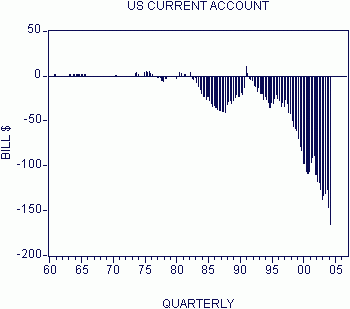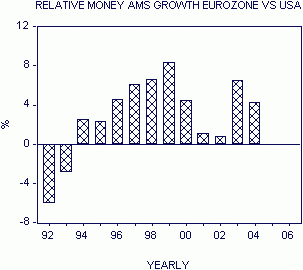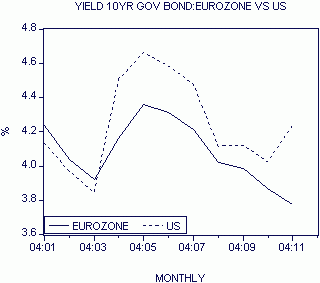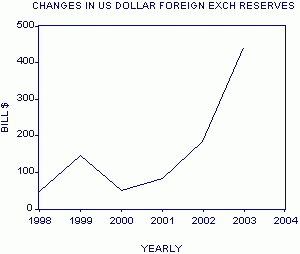Rumors that China’s central bank has reduced its holdings of US Treasuries in favor of European assets is putting more pressure on the already battered US dollar. After closing at US $1.274 in October, the price of the Euro in US dollar terms shot up to around US $1.33 on Friday November 26. According to the Shanghai-based China Business News, China has cut the size of its US Treasury Bonds holdings to $180 billion.
This decision, according to the newspaper, was taken by government officials in order to avoid losses from a weakening US dollar. The latest data shows that China’s holdings of US Treasuries stood at $174.4 billion in September—the second largest foreign holder of US Treasuries after Japan, which holds $720 billion. Both Japan and China hold about 48% of US Treasuries held by foreigners.
The possibility that the Chinese authorities may lower their holdings of US assets and substitute them for European assets is seen as a major threat to the US dollar and seems to support the view of most experts. For instance, in his speech on Friday November 19 the Chairman of the Federal Reserve Alan Greenspan suggested that foreigners might get tired of financing the ever-growing US current account deficit, which stood at a record $166.2 billion in Q2.

At some stage, Greenspan maintains, foreigners will start shifting their money away from US assets thereby depressing the US dollars and lifting the interest rate structure. This in turn will undermine the pace of US economic activity, so it is argued. According to this way of thinking, as long as the US continues to run a massive current account deficit the pressure on the dollar and on the US economy will stay intact. Hence the only solution to this predicament is to devise policies that can tackle the problem of the growing deficit.
But is it true that the state of the balance of payments determines the currency rate of exchange?
Exports and imports in a market economy
Every participant in a market economy is a seller and a buyer of goods and services. In his capacity as a seller of goods he exports those goods to other individuals. While in his capacity as a buyer of goods he imports these goods from others. Every individual in a market economy is both an exporter and an importer.
For instance, a baker that produced ten loaves of bread and consumes two loaves can now sell, i.e. export, eight saved loaves of bread to a shoemaker for a pair of shoes. The pair of shoes that the baker secures for the eight loaves of bread is his import. Note that he paid for the import with his export, i.e., eight loaves of bread is payment for the pair shoes.
The essence of this exchange is not altered if, let us say, the shoemaker resides in Europe while the baker is located in the US.
The introduction of money does not alter the essence of what we have said, i.e., that individuals pay for their imports by means of exports. A producer exchanges the goods he produces for money and then employs money to secure, i.e. import, goods from other producers.
As with the price of goods, the supply and demand for money determines the price of money, or its purchasing power. For a given supply of money an increase in the production of goods implies that producers will demand more money since more goods must now be exchanged for money.
As a result of this, the purchasing power of money will increase. Every dollar will now command more goods. Conversely, if the supply of money increases for a given stock of real goods, the purchasing power of money falls since now there are fewer goods per dollar. The prices of goods and services are set in motion by relative increases in money against rises in goods and services.
If a given basket of goods is exchanged in the US for one dollar and the same basket of goods is exchanged for two euros in Europe, the rate of exchange between the US dollar and the euro will be set as one dollar for two euros. Any deviation of the exchange rate from the level dictated by the purchasing power of currencies will set corrective actions in motion on behalf of buyers and sellers.
Suppose that the rate of exchange, as a result of various transitory factors, was set in the market at one dollar for three euros. This means that in relation to its purchasing power the dollar is now overvalued, i.e. too expensive. This gives rise to speculative corrective actions. It will pay now to sell the basket of goods for dollars then exchange dollars for euros and then buy more goods with euros—thus making a clear arbitrage gain.
For simplicity’s sake, assume that one kg of potatoes is exchanged for one dollar in the US and two euros in Europe. In this case it will pay to sell one kg of potatoes for one dollar, exchange the one dollar for three euros, and then exchange three euros for 1.5 kg of potatoes, gaining 0.5 kg of potatoes. The fact that holders of dollars will increase their demand for euros in order to profit from the arbitrage will make euros more expensive in terms of dollars and this in turn will push the exchange rate in the direction of one dollar to two euros.
Observe that the underlying rate of exchange, as set by the relative purchasing power of monies, as such has nothing to do with the state of the balance of payments. The fact that the baker has exported eight loaves of bread for the import of one pair of shoes doesn’t alter the respective purchasing power of the dollar and the euro.
As we have seen, the purchasing power of money is set by the relative scarcity of money in relation to real goods and services. The fact that the American baker has entered an exchange with the European shoemaker didn’t alter the given stock of money and the given stock of bread and shoes. It follows then that if the currency rate of exchange in the foreign exchange market will be set in response to trade balances and in disregard to the relative purchasing power of monies such a rate of exchange can’t be sustained.
The China Question
How is all this related to the possibility that China or other countries may shift their asset allocation away from the US toward Europe? Now, let us assume that this shift, which is motivated by the growing US current account deficit, runs contrary to the underlying exchange rate, i.e., as set by the relative purchasing power of monies. If according to the underlying exchange rate the dollar is not too expensive (not overvalued), the fall in the dollar on account of non-USD asset allocation by China will be of short duration. The reason for that, as we have seen, will be actions on behalf of buyers and sellers that will bring the rate of exchange in line with the relative purchasing power of respective monies.
On this score between 1994 to 2004 the Euro-zone money printer has been working much faster than its American counterpart (see chart). In other words, money growth in the Euro-zone relative to the growth of real goods and services has been much larger than in the US.

This in turn raises the likelihood that the US dollar is not overvalued against the Euro, implying that the Chinese factor can only have a short-lived effect, all other things being equal. Thus a fall in the dollar against the Euro will make it advantageous to sell goods for Euro’s, then exchange Euro’s for US dollar. Then with more dollars one will be able to secure more goods and services. Obviously this will set in motion corrective forces until the rate of exchange gravitates toward the underlying rate of exchange.
What about interest rate differentials? According to popular thinking a relative rise in interest rate in Europe against the US will prompt investors to sell US assets in favor of European assets, i.e., selling dollars and buying euros thus raising the euro rate of exchange versus the dollar. Again, if at a given point in time the emerging exchange rate on account of the interest rate differential doesn’t correspond to the underlying rate of exchange, arbitrage activities will be set in motion, which in turn will bring the market rate of exchange in line with fundamentals.
With respect to the interest rate factor the latest data is actually favorable for the dollar. For the past eight months the yield on the US 10-year T-Bond has been higher than the yield on the 10-year Euro-zone government bond. For instance, in October the US yield stood at 4.025% against 3.87% in the Euro-zone. So far in November in the US, the yield stood at 4.24% against the Euro-zone rate of 3.77%.

What is the importance of the balance payments statistics?
The balance of payments statement of a particular company could be of assistance to various present and potential investors in that company. But what possible interest can a business have with the national balance of payments? Will this assist him in his business conduct?
Because there is no such thing as US Inc. that can be bought and sold in the market, the national balance of payments will be of no use to businesses. Furthermore, it is not the US that exports wheat, but a particular farmer or a group of farmers. They are engaged in the export of wheat because they expect to profit from it.
Similarly it is not the US that imports Japanese electrical appliances, but an individual American or a particular group of Americans. They import these appliances because they believe that a profit can be made.
Now, whenever an individual plans to import more than he exports, the shortfall will be balanced either by running down existing savings or by borrowing. The creditor who supplies the required funds does so because he expects to profit from that.
Subsequently, if the debtor, for whatever reasons, cannot honor his debt, this financial crisis is only of concern to the parties involved and of little importance to other individuals in the community. The idea of calculating the so-called national balance of payments in a free market economy will be absurd.
However, this is not so when government and the central bank are actively tampering with markets. In this context the reading of the balance of payments can provide some useful information regarding the damage that government and central bank policies have inflicted.
In the US context, the ever-widening current account deficit is the manifestation of the fact that despite the loose monetary policies of the Fed foreigners are still happy to be paid with US dollars. Thus in 2003, holdings of US dollars in foreign exchange reserves by central banks increased by $441.3 billion after rising by $184.5 billion in the previous year.
As a percentage of total foreign reserves, US dollars comprise 69% with Euros about 20%, while the rest is held in Yen, Pound Sterling, and Swiss Francs. The popularity of the US$ is an important vehicle for diverting real savings from foreigners to Americans. If this popularity were to weaken obviously it would be much harder for Americans to divert real savings from the rest of the world.
By printing the most popular international medium of exchange, the US central bank enables the first receivers of dollars that happened to be Americans to divert real wealth from the rest of the world.

Loose Fed monetary policies have enabled Americans to engage in consumption without the backup of the production of real wealth. That is, Americans have been engaged in nonproductive consumption.
Obviously nonproductive consumption implies importing without exporting that results in a current account deficit. In this context the ever-growing current account deficit, which stood at $166 billion in Q2, provides a measure of the magnitude of how far nonproductive consumption has developed in the US.
So the alarm raised by Greenspan, whilst valid, should actually be addressed toward his own monetary policies. Curiously, in all his speeches the Fed Chairman has chosen to ignore the Fed’s contribution to the current currency turmoil. Luckily for the Fed other central bank’s policies are just as bad, thereby providing a support for the underlying US dollar rate of exchange.
Conclusions
China and other countries possibly shifting away from US assets toward European assets may temporarily weaken the US dollar against the Euro. It cannot, however, alter the underlying Euro/US dollar rate of exchange. What sets a rate of exchange in motion is relative increases in money supply against increases in goods and services.
Over time, relative increases in money supply set the purchasing power of US and Euro-zone monies and this in turn sets the underlying rate of exchange. On this score our analysis shows that since the formation of the Euro-zone its money printer has been working much faster than its American counterpart.
We suggest this raises the likelihood that the US dollar is not overvalued (not too expensive) against the Euro. Consequently, the Chinese factor can only have a short-lived effect on the dollar, all other things being equal. A fall in the US dollar on account of the Chinese factor against the Euro will set in motion corrective actions on behalf of buyers and sellers, which will bring the US dollar toward its underlying rate of exchange.


